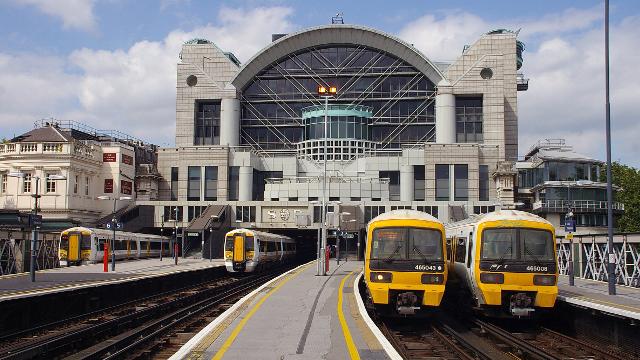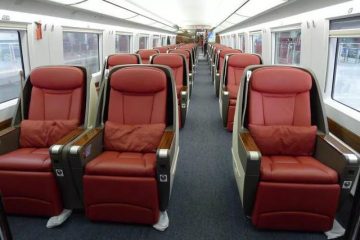The British Train Company’s Charing Cross Railway Station (also known as London Charing Cross Station) is the London Central Railway Terminal between Westminster’s Strand and Hungerford Bridge. It is the terminus of the southeast main line from Ashford to Dover. All trains are operated by the Southeast Railway Company, which provides most commuting and regional services to South East London and Kent. It is connected to the Charing Cross underground station and is close to the Embankment underground station and the Embankment Pier.

The station was originally built in 1864 by the Southern Railway. Its name comes from the location near the Charing Cross, the conceptual “London city centre”. In the 19th century, the station became the main destination for London’s transport by train to the mainland and provided several prestigious international services. In 1905, it was severely damaged by engineering accidents and was extensively rebuilt. It then became an important meeting point for military and government traffic during the First World War. At that time, some politicians thought that Charing Cross Station was outdated and made recommendations. Replace the Hungerford Bridge with a road bridge or a road/rail combination and move to the south bank of the Thames. The station was bombarded several times during the Second World War, then rebuilt and reopened in 1951. In the late 1980s, the station complex was redesigned by Terry Farrell and remodeled to accommodate the modern office building now known as Embankment Place.

Charing Cross Station is located at the western end of Strand in Westminster, east of Trafalgar Square, northeast of Whitehall. It is close to the dike pier and provides river services along the Thames. The railway leads directly to the Hungerford Bridge and crosses the river to the London Borough of Lambeth.
The station number is CHX, one of the 19 stations managed by British Rail Network Rail and the 14th busiest station in the UK. There are many major bus routes in the area and it is designated as “Charles Trafalgar Square”
The station is planned to be the London terminus of the South East Railway (SER). Originally wanted to extend this line from the bricklayer ordnance factory to the Hungerford Bridge, but a bill proposed in 1846 was unsuccessful. In 1857, Congress proposed that a railway terminal would be established at the western end before reaching an agreement with the London, Brighton and South Coast railways to build a route from the London Bridge to the west.

The construction of the route to Charing Cross Street was costly because it crossed a densely populated area when the company chose to upgrade the two lines to three and double the capacity of the bridge to four lines. The bridge replaces the original suspension bridge designed by Isambard Kingdom Brunel in 1845. The project began in June 1860 and lasted about three years. The old suspension bridge remained open until the new bridge was suitable for manned. The trial operation was carried out on December 1, 1863.

Designed by Sir John Hawkshaw, the station features a single-span wrought iron roof, 510 feet (155 m) long and 164 feet (50 m) wide, arched over six platforms on a narrow site. on. It is built on a vaulted brick viaduct with rail levels above the ground up to 30 feet (9 m). The space under the line is used as a wine cellar. The roof above the track is a single 164-foot (50 m) wide arch that rises to 102 feet (31 m).
Charing Cross Station was officially opened on January 11, 1864. The Charing Cross Hotel, designed by Edward Middleton Barry, opened on May 15, 1865 and provided the station with a magnificent French Renaissance décor. It has 250 bedrooms spread over seven floors, extending along Villiers Street and the front of the Strand. The public room has a balcony overlooking the lobby of the central railway station. In 1878, the 90-bedroom annex was opened on the other side of Villiers Street. A bridge on the street connects the two parts of the hotel.
- Name: Charing Cross Station London Charing Cross Station
- Address: 12-30 Strand, Charing Cross London, WC2N 5L


The Charing Cross railway station is located in London and is the station of the London Underground and the National Railways and the premier transportation hub of London. Most of the train services are provided by Southeastern Railway Company and Southern Railway Company (Southern).
The station is located near Trafalgar Square and Whitewall. It is close to the Embankment Pier and offers ferry services along the Thames. London’s famous Bookstore Street, Charinger Road and London Chinatown are also not far from the station.
.png)
After the opening of international services, Charing Cross Street became the main destination for all SER services, not the London Bridge, including ships to the European continent. Together with Victoria, it became the main starting point from London to abroad, and was called the “gate of the world” by Percy Fitzgerald. Thomas Cook built a travel agency around the corner of the front yard of the station. The SER route was the shortest route from London to Dover after the renovation of Sevenoaks in 1868.
Thanks to its international ties, the Charing Cross played an important role in the First World War and became the main starting point for the military and the government to move westward. On August 3, 1914, all civilian and public vessel services were suspended. The return journey from Dover took the wounded and the wounded to the intersection of Charing Cross and was sent to hospitals across the country. During the war, there were 283 trains departing from the station. Shortly after the war, on December 26, 1918, US President Woodrow Wilson met with King George V at Charing Cross. The commercial cross-channel service was restored to Ostend on January 18, 1919, to Boulogne on February 3, and to Calais on January 8, 1920, but by that time, Victoria has expanded to accommodate Strict wartime immigration and customs inspections, checkpoints and crossroads are no longer important as international terminals.
The 1905 roof collapsed. The original roof structure was 70 feet (21 m) long, including two end compartments and some western walls in the south of the station, which collapsed at 3:57 pm. December 5, 1905. Shortly after 3:45 pm, the roof made a loud noise, when someone noticed that a main tie rod broke and hanged. Part of the roof began to sink and the western wall began to crack.
There were still 12 minutes of collapse, which allowed the train and platform to be evacuated, and the trains that entered the station were blocked. The roof, girders and debris fell on four passenger trains, blocking all tracks. The collapsed Western Wall was partially destroyed by the walls and roof of the Northumberland Avenue adjacent to the Royal Mile Theatre (now the Theatre Theatre), which was being rebuilt. Six people died (two workers on the roof, a supplier to the Smith Bookstore and three workers at the Royal Mile Theatre).
At the accident investigation committee, the eyewitness of the expert expressed doubts about the design of the roof, even if the failure was due to a welding error on the tie rod. Although the SECR believes that the roof has a service life of at least 40 years, they decided not to repair it, but to replace it completely. The station was reopened on March 19, 1906.
The old reservation was removed and the various rooms on the ground floor were relocated. A new 58 by 22 foot (17.7 m by 6.7 m) reservation hall was built, as well as a separate ladies waiting room. Additional remedial work was completed in 1913.
By the end of the 19th century, Charing Cross was considered inconvenient. In 1889, John Burns of the newly formed London County Council proposed the removal of the station and its entrances and exits and the construction of a road bridge. The idea was supported by the parliament because it could expand the Strand and lay a road on the Thames that would bypass Whitehall. When the SECR filed a bill to Congress in 1916 to strengthen the bridge, Burns suggested that the station was in the wrong position and should be rebuilt on the south side of the Thames. The following year, a bill was passed to rebuild the bridge, and its appearance was strictly regulated, and the station building itself was prohibited from being enlarged.
After the merger of the four major groups, the ownership of the Charging Cross was handed over to the Southern Railway (SR) in 1923. The line was electrified in 1926 to meet suburban service needs. It has been found that the light load of the multi-unit electric train relieves the pressure on the bridge, so the traffic has been redesigned to run local services on earlier sections.
In 1926, the Royal Cross Transport Commission proposed the conversion of the Hungerford Bridge to a double-deck road/railway bridge and the construction of a new Charing Cross station on the eastern side of the old bridge. SR approved this idea as it will allow them to extend the site. Two years later, another suggestion was made to build only roads and bridges and to relocate the station to the south of the Thames because it was much cheaper. Prime Minister Stanley Baldwin urged the Soviet Socialist Republic to accept the proposal as “a matter of national importance”, but after the 1930 election committee did not accept the establishment of a new Chad Cross in the South Bank failure. The proposal was officially rejected in 1936 by the London and the County Transportation Advisory Committee, which restored the choice of double-deck bridges. After the outbreak of the Second World War, these plans were abandoned.
During the Second World War, Charing Cross suffered major damage during the air strikes. On October 8, 1940, in a daylight raid in Whitehall, the train was hit. On the night of April 16-17, 1941, the hotel was destroyed by fire and explosives. Four trains caught fire and several fires broke out on the bridge. A 28-pound (3,100 lb; 1,400 kg) long parachute mine landed next to the platform 4. The station has been closed to repair damage and evacuate mines. Another raid was carried out on the evening of May 10/11, causing the station to close again. On June 18, 1944, a bomb exploded the span of the bridge. It did not resume normal operation until December 4th.
After the war, the hotel was extensively repaired in 1951. This includes a whole new top floor, while the sloping roof of the upper floors of the hotel is made of ordinary new Georgia white bricks.
modernization
In 1974, the ticketing hall and the ticket office were modernized. In 1983, the first electronic ticket printing was piloted at the station.
In 1986, redevelopment began in most areas above the platform. The new building is named Embankment Place, a postmodern office and shopping centre designed by Terry Farrell and Partners. This development led to the replacement of the roof in almost the entire 1906. [15] The last two spans of the structure (next to the existing auditorium top) are retained as part of the enlarged waiting area. In addition, the original fixed side wall that once supported the station is still in a near-complete state. The project was completed in November 1990. Most of the buildings on the embankment are office space, and there are many restaurants on the first floor.
The station has six platforms. All trains will stop at Waterloo East and London Bridge
As of May 2018, the hourly train service (tph) is
2tph Bexleyheath arrives in Teford
2tph Sidcup arrives in Teford
Sidcup to Gravesend 2tph (semi-fast)
2tph Lewisham and Woolwich Arsenal to Dartford
2tph Grove Park to Sevenoaks
2tph Hastings (1 semi-fast and 1 parking)
2tph Tunbridge Wells
1tph Dover Priory
1tph Canterbury West to Ramsgate
Charing cross station Chad Cross Station to Edinburgh

Charing cross station Charing Cross Station to Oxford



0 Comments